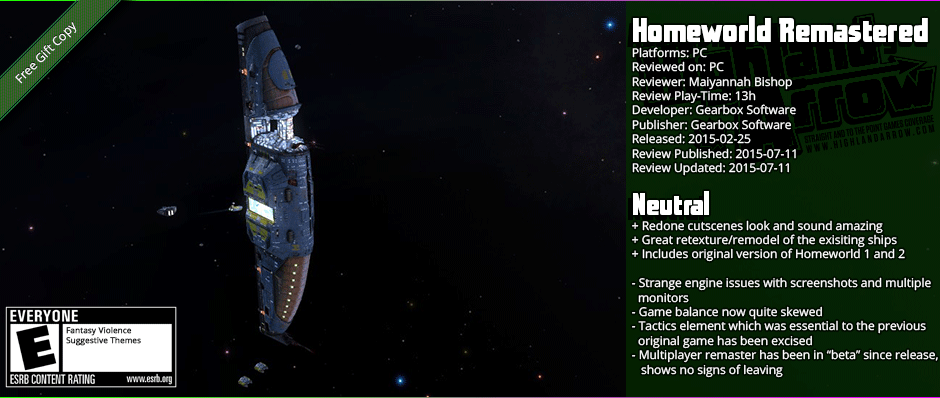

Editor's Note: Maiyannah's copy of the game was provided free of charge by a reader as a gift.
Homeworld Remastered is a collection of a HD version of both the original Homeworld and Homeworld 2 as well as the originals, with the originals as you may know developed by Relic Entertainment and published by Sierra, and the new remasters being developed and published by Gearbox Software. Homeworld has a special place in my heart, being one of the first RTS I played back in the day, and one with a brilliant story told through some great action and cutscenes both with brilliant voice acting, but more importantly, one with a lot of depth to the strategy. So the Remastered Collection was something I looked forward to getting a look at, especially when it came highly-recommended by the likes of TotalBiscuit and company. And, well, I've played much worse games (WWE 2k15 comes to mind), but I've never been let down this much by a game. Here is a game reboot/remaster that may look better, but it's lost the soul of the game in the translation - it forgot what made this game great.
Tampering with the game's balance and core mechanics
has subtly but irrevocably diminished Homeworld Remastered
To understand how this has happened, one needs cast their minds back to the original Homeworld. For those that haven't played the original: you have a variety of formations and tactics available to assign to each unit. Formations were things like a chevron, the "claw" that was said in three-dimensional space, three-dimensional spheres, capital ship lines, frigate firing formation, and then things like aggressive, defensive, evasive tactics, and the like. Each of these different formation and tactic combinations had costs and benefits and were effective in certain situations and ineffective in others. This created a great depth of tactical options in the game and required a fair bit of knowledge. The AI was smart about it though: it would maintain formation cohesion and generally not get kited unless you had enabled the aggressive tactics.
Homeworld Remastered, however, has abandoned that tactical nuance, in just about every fashion. The ships no longer retain formation cohesion, nor do the formations offer any real specific benefit anymore, and the tactics are reduced to a simple incremental scale of aggressive, defensive, and passive, which are weapons hot, fire only if fired upon, and hold fire respectively, rather than any nuance. Furthermore, even if the ships are passive, the AI will often get kited, and thus even maintaining a simple firing line can become an incredible amount of micro-management. This basically comes down to the fact that the AI programming is vastly inferior here than it was in the original, very single-purpose and easily manipulated, and that goes for both player and CPU AI.
What isn't on the AI however are the balance changes, with pretty much every ship having gotten tweaked in some way or another. Most of them are inoffensive, excepting that capships are pretty much useless against fighters. But oh, speaking of fighters ... that's the big sticking point here. So the obvious intention was to simplify what was already a rather rock-papers-scissors approach with ships even further, making capships useless against fighters, fighters useless against frigates, and frigates useless against capships. Thankfully, capships are unlikely to be harmed by fighters, because they do almost no damage. In the spirit of scientific experimentation, I left a wing of five destroyers in the middle of an AI opponents fighter wings, which was an equal mix of Defenders and Attack Bombers, and knocked off to get a sandwich for dinner. 15 minutes of preparing and eating said sandwich while I watched a youtube video later, they had managed to damage a single one of the destroyers (which were passive and thus not defending themselves) about half of the way. Fighters are, for most intents and purposes, nerfed into oblivion, only really useful as a screen of distractions or to otherwise draw an enemy away, by virtue of the lacking artificial intelligence.
The frustration of that usefulness of fighters comes during the Sea of Lost Souls mission, as the mission's conceit is that you cannot use capital ships against the enemy, or the enemy would take control of them - rather, you had to use either fighters or corvettes. And given fighters are useless and corvettes get eaten alive by the fleet of enemy frigates and the destroyer defending the target mothership, well, that mission was pretty much an exercise in frustration - one they did not modify at all for their balance changes, and indeed none of the story missions have been modified accordingly.
The story campaigns' storytelling
has been vastly improved upon by the remaster
Part of that frustration with the story campaign in this respect is that while playing it is so bloody frustrating, this is the same compelling Homeworld story you remember, and not just that, one that's seen a good deal of polish and improvement. The cinematics and sound are redone quite excellently, resampled and touched up in a way that's obviously using original source files or the like since it does not vary greatly from the original except in the level of quality, and that really is the main appeal here I suppose: from stem to stern so to speak the game has gotten modern upgrades.
The big thing here too is that it's not been at the loss of Homeworld's style. Care has been given to retaining the original designs and merely refining upon them: more polygons, higher-resolution textures, and such, rather than complete redesigns. It all feels very "Homeworld" and a great deal of attention has been paid to keep the look and feel of the classical Homeworld games. This makes the fact that they so much lost the feeling of the actual mechanics such a puzzling thing; perhaps they ended up missing the trees for the forest, so to speak, and focussed so much on the visual style they lost track of the mechanics. To be honest though, game design has never been Gearbox's strong suit, and it comes to me as no surprise they would favour a more simplistic gameplay design and could not get a grasp on the deeper fundamentals.
That digression aside, the engine is hardly flawless however, and while it runs at a decent framerate on modern computers with little difficulty, there are a lot of problems reported in regard to playing the game on AMD cards, and I had several strange issues that seemed to be related to running the game on multiple monitors, with it somewhat frequently taken to a strange rapid flickering that would persist until you alt-tabbed out of the game and back in, and occassionally dumping you to the desktop even as the game still run because the window wasn't properly catching the mouse. Given the main appeal of this game is a more technically-modern engine, these issues come as a great disappointment, as does the game in general. Taking screenshots also had some strange artifacting issues, even when I saved them uncompressed with steam. The artifacts you see in the header and footer screenshots are from the game's screenshots I have taken, but oddly, they do not appear in actual gameplay.
Multi-player has been in a mostly unplayable state since release
Issues with the story campaign not having been rebalanced along with the game, and the AI not being all that intelligent, are further compounded by the fact that the multi-player is not stable, has difficulty creating matches, and often drops them midway, so I couldn't for example say "well, the single-player is diminished now, but the multi-player is still great" - because of the difficulty of seeing a game through to its completion. Said multi-player has been labelled as a beta since release, and it shows no real sign of being ready to leave said beta anytime soon, so if you are hoping to pick it up as a multiplayer RTS title, well you're best served waiting.
I've come across very negative in this review, and you are probably wondering why I still label it neutral in that light, and well, it is pretty simple: Homeworld was one of the masters of its genre when it originally released, a GOTY title in many publications and one of my favourite games. Even the complete ineptitude with which Gearbox seem to have handled the title hasn't completely ruined it - this is still the same captivating story of exploration, seeking the way home it once was. But its one that has suffered greatly for those whom came after, and hopefully they fix these short-comings.


